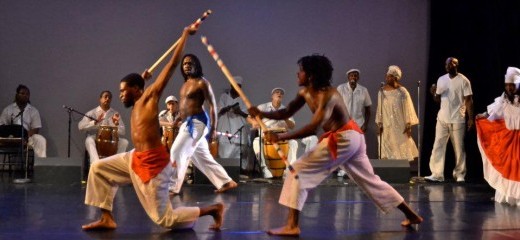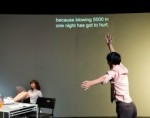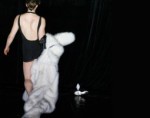
Many Feet, One Step: Kùlú Mèlé Leads a Journey
by R. Eric Thomas
The total experience of Kùlú Mèlé’s Sacred Journeys began far before the first drum was struck or the first dancer took the stage. The venerable African dance and drum ensemble, a Philadelphia institution for over 40 years, hosted a bustling bazaar outside of the theater prior to the group’s fall performance. Jewels, baubles, shimmering fabrics and baked treats competed for the attention of mingling audience members, many of whom appeared to be well-acquainted friends. More than a gimmick, the bazaar served as a perfect precursor to an evening of dance that dazzled, astounded and—above all—emphasized the enduring power of community.Sacred Journeys, a densely packed two-hour program comprised of four dances and two musical interludes, featured a range of choreography in African and Afro-Cuban traditions featuring Kùlú Mèlé’s indefatigable troupe and accompanied by five drummers. The evening began on a playful note with Elegba, choreographed by company Artistic Director Dorothy Wilkie. A tribute to the eponymous Yoruba demi-god, who is known for mischief, the dance immediately filled the stage with sound and action. The company—12 women and three men—entered en masse performing an intricately coordinated series of simple phrases—sprightly hops, playful fights, jubilant cantering—which resolved into a graceful circle dance. The mischievous nature of the dance’s subject was written boldly across the face of each dancer in sly grins and wide eyes. This was an ebullient piece and it showed in every energetically synchronized gesture, from eyebrows to feet.
Elegba’s jubilant spirit stood in stark contrast to the tone of Pao, an Afro-Cuban dance that closed the first half of the program. The company’s women, clad in flowing white petticoats with top skirts of either red or blue, strutted on stage defiant and stone-faced, heralded by off-stage screams. Gone were the grins and the playful movement phrases; this was a dance of power, of aggression and of competing skills. Pao was meant to depict the battle between good and evil and the dancers, divided into groups of red top skirts and blue, played out this conflict with thrusting, sometimes striking arms, stomping feet and preening showmanship. The red group danced first, flipping their skirts coquettishly while taking warrior-like stances and advancing menacingly. The blue group responded in kind, only to collapse and crawl off-stage in apparent defeat. At the end of Danys “La Mora” Prades’ vibrantly choreographed fight-dance, both groups merged, flooded the stage and faced outward in a staggering flurry of whirling fabric and limbs.
The two dances featured in the second half of Sacred Journeys had a more definitive narrative arc, which helped to underscore the theme of strength in community and respect for ancestors. Babalu-Aye, choreographed by Wilkie, told the story of a village sickened by tainted water. An elder woman, danced by Wilkie, invoked the spirit of Babalu to heal the writhing villagers. The company was clad in burlap skirts with fringe, which was accentuated by the two-step gestures and shrugs on which Wilkie built her choreography. A straight-forward, simple piece, Babalu-Aye still retained a heightened sense of drama through the intensity of the percussion and superb emoting on the part of the dancers.
The final dance, Bao, was a restaging of a dance last performed seven years ago. Danced in the tradition of the Toma ethnic group of Guinea, it celebrated two young girls’ initiation into adulthood. Even more than the jubilant Elegba, Bao was a dance of heartfelt joy and deep ceremonial import. The company, adorned in stunningly elaborate headdresses and black skirts covered in multi-colored tassels, entered singing their own accompaniment. The troupe suddenly exploded into a fast-paced celebratory dance, each arm raised triumphantly, each foot shooting forward. One is tempted to describe the movements of the dancers as wild or flailing, but such terms denote only the passion exhibited, without giving credit to the precision. There was not a careless gesture in the entire dance. Every arm, raised and bent with fist clenched, was placed with exacting care. Every foot, skittering beneath jutting legs, was a testament to the collective power and skill of Kùlú Mèlé’s company. Every limb, every body part on each dancer gyrated of its own accord, yet in perfect synchronicity with every other limb and part on stage. This, perhaps, is the enduring takeaway from Sacred Journeys: each dance, each dancer, drummer or aspect of Kùlú Mèlé’s program was impressively strong but it was only through combined, expertly coordinated craftsmanship that the company was able to create a phenomenal experience.
Kùlú Mèlé, Sacred Journeys, The Painted Bride, November 26 and 27, 2011. No further performances.
By R. Eric Thomas
November 30, 2011










